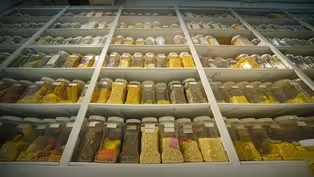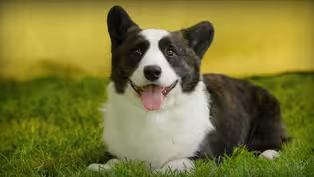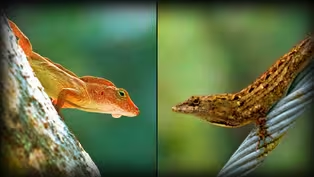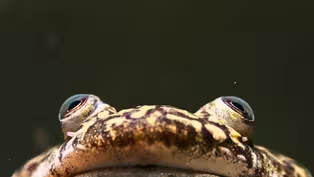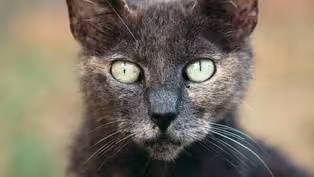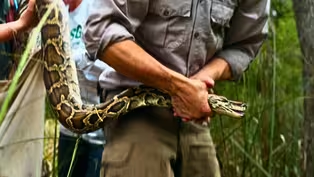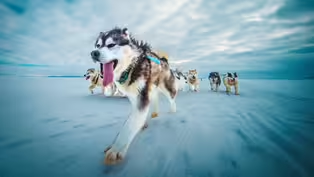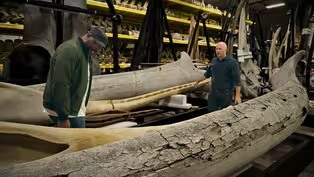
How NYC Became a Rat Kingdom
Special | 13m 26sVideo has Closed Captions
When it comes to NYC, the rat is the undisputed king!
When it comes to NYC, the rat is the undisputed king of the urban jungle — and we made it that way! Find out why with host and evolutionary biologist Shane Campbell-Staton in this episode of Human Footprint.
Problems playing video? | Closed Captioning Feedback
Problems playing video? | Closed Captioning Feedback

How NYC Became a Rat Kingdom
Special | 13m 26sVideo has Closed Captions
When it comes to NYC, the rat is the undisputed king of the urban jungle — and we made it that way! Find out why with host and evolutionary biologist Shane Campbell-Staton in this episode of Human Footprint.
Problems playing video? | Closed Captioning Feedback
How to Watch Human Footprint
Human Footprint is available to stream on pbs.org and the free PBS App, available on iPhone, Apple TV, Android TV, Android smartphones, Amazon Fire TV, Amazon Fire Tablet, Roku, Samsung Smart TV, and Vizio.
Buy Now

Surprising Moments from Human Footprint
Do you think you know what it means to be human? In Human Footprint, Biologist Shane Campbell-Staton asks us all to think again. As he discovers, the story of our impact on the world around us is more complicated — and much more surprising — than you might realize.Providing Support for PBS.org
Learn Moreabout PBS online sponsorshipMore from This Collection
Human Footprint is a show that delves into the impact of humans on the planet. Join Shane as he travels from farms to restaurants, from high-tech labs to street markets, and from forests to cities to uncover the consequences of our unique history. Are you ready to explore our past, present, and future as a species?
Video has Closed Captions
Watch the rise of a productive crop that has managed to replace itself, but at what cost? (11m 24s)
The Watery Price Of Golf Courses & Lawns
Video has Closed Captions
The cultural and resource costs for manicured lawns and golf courses are quite shocking. (11m 29s)
How Dogs Are Shaping The Future Of Medicine
Video has Closed Captions
Observe the rich diversity of dog breeds, shaped by genes and human intervention. (12m 43s)
We Brought This Fish To America. Now We Can't Get Rid Of It
Video has Closed Captions
Expose Asian carp for disrupting native fish species and shrinking their populations. (10m 39s)
Why Are These Urban Lizards Evolving in Overdrive?
Video has Closed Captions
Examine city-dwelling anoles with remarkable evolutionary changes. (10m 33s)
How An Ancient Ocean Shaped Us History
Video has Closed Captions
Learn how millions of years of deposits shaped the events of Black American history. (16m 54s)
Video has Closed Captions
What happens when frogs become indispensable? (8m 59s)
Your Cat’s Secret Life (as a Deadly Predator)
Video has Closed Captions
Cats have been winning the hearts of humans for years....but can devastate ecosystems. (10m 40s)
Singapore: Designing a Megacity in Harmony with Nature
Video has Closed Captions
Green spaces aren't just an afterthought here - they're mandatory! (13m 24s)
How Giant Pythons Became Florida’s Biggest Invasive Species
Video has Closed Captions
Ever heard of the phrase "when pet pythons outgrow their owners"? (13m 24s)
Sled Dogs: The Most Extreme Distance Athletes on Earth
Video has Closed Captions
In the Arctic, it's not just about muscle power, but brainpower too. (15m 17s)
Secrets of the World’s Only Whale Warehouse
Video has Closed Captions
Uncover the history of whaling and its impact on our oceans. (9m 58s)
Providing Support for PBS.org
Learn Moreabout PBS online sponsorshipNew York City has 25,000 restaurants – not counting the pizzerias – and millions of home chefs.
Three nights a week, their trash ends up not in a dumpster, not in a can with a lid…but right on the curb.
And that’s when the rat buffet begins.
They say if you can make it in New York, you can make it anywhere.
And rats…well, they made it.
But how did they get here in the first place?
And how do we make them go away?
I’m Shane Campbell-Staton, and this is Human Footprint.
As a New Yorker, I always lean towards pepperoni.
I can respect that.
Bobby Corrigan is one of those 8 million New Yorkers.
He loves everything about this place: a good slice of pepperoni, the city lights, and oh yeah…rats.
In college, I had to save money, so I took a job as an exterminator.
They put me in the sewers right away, and I thought, oh, this is cool.
Literally working your way from the bottom up.
Exactly.
Bobby spends his free time writing poetry on the street… but by day, he’s a world renowned Urban Rodentologist.
Are rats the scourge that people make them out to be?
I admire them.
I respect them.
However, they live in dirty areas.
And that dirt got cooties.
It’s viruses.
Bacteria.
Fungi.
Protozoans.
55 different diseases.
55?
55.
Wow, okay.
And think of the plague, Shane.
I mean, 25 million people go down with the black rat and their fleas.
Yeah.
No place needs Bobby’s expertise more than New York, where it seems like rats are… pretty much everywhere.
Here we are, sitting at a restaurant.
If that door over there is not pest proof into the pizza shop across the kitchen counter and urinates and defecates and leaves the film.
And then someone touches the film the next morning and then, boom.
This pizza’s tasting a little less good now.
Yeah.
It was time to walk off that pizza on what Bobby calls… a Rat Safari.
We're going to cross over here, Shane.
There's a park here.
Here we are, almost at the end of June.
Their breeding season is in full swing.
Love is in the air.
Love is totally in the air.
And families are growing.
We know that rats are the most prolific of all mammals.
A single pair of rats would become 360 million in the short space of three years.
As the sidewalks begin to deteriorate, rats will move below the sidewalks for their burrows.
You’re literally sometimes walking right over the tops of the heads of rats.
Sometimes rats will go right up the tree…if there’s a bird nest up there, they’re predacious on those birds.
Is the reason why you're wearing the hard hat because a rat might jump out of the tree onto you.
And is that something I need to worry about?
Actually, that would be cool if they would jump onto me.
I'd like that a lot.
Okay.
The longer rats live in our cities, the better they get at it… and the harder we try to keep them out.
Here we have something that's very common: the bait box.
The rats will go inside that box and find the poison bait.
And eight, nine, ten days later, they die.
But no matter how much poison we throw at the problem… We're also throwing rats a lifeline.
Food in a big city of high density humans is extremely reliable.
So this becomes like basically the rat buffet.
It does.
It’s hard to imagine New York City without rats… so how did they become such a fixture here?
If we want to know the story of rats in New York City, we have to know what were they doing before they got here.
This is Jason Munshi-South.
He’s a biologist who loves New York City almost as much as he loves rats.
When the brown rat made it here, it sort of hit the jackpot.
The brown rat, or Rattus norvegicus, probably originated in East Asia, where it was first drawn to human settlements by agriculture.
But as people around the world moved into dense cities full of trash, human waste, and safe hiding places, rat populations soared.
Without meaning to, we built a rat paradise.
Rats don’t have to go to much trouble to find homes because we provide these for them.
Made to order.
Everything but the welcome mat.
It’s like, hey.
There’s this massive free food here now and all I gotta do is hang around these people.
At the height of European imperialism, rats were already entrenched in cities and ports across the Old World.
So, when European explorers sailed west into the unknown, rats did what they've always done, and came along.
How do we know what we know about how rats spread across the planet?
We extract DNA out of those bits of rat from around the world, and then we look at either the whole genome or portions of the genome and we compare the genetics of a rat from Thailand to all the other populations.
You start to see the historical narratives will roughly match up.
Then, you see this massive number of populations that are all closely related around the period of European imperialism, and it matches Western Europe and all the places they went.
Where we are now is where the Dutch bought the island or stole the island.
I put my money on stole, but go ahead.
By the early 1900s, it wasn't just white human settlers who’d colonized all of North America.
It was also rats.
But not all rat habitat is created equal.
Yeah as you’re driving from Battery Park where the rats first came in, up to here.
And this is one of the great rat neighborhoods of the world.
But if you keep rolling north, the whole vibe changes.
And Jason’s got the data to prove it.
We got basically about 70,000 points where rats have been identified.
And this is the outcome of the map, where the green areas are really good rat neighborhoods like where we are right now, right about there… Okay Near Tompkins Square.
But then see this red area here south of Central Park?
Uh-huh.
That's Midtown where there isn't a lot of residential.
The companies pay extra money to have the streets cleaned up.
And it seems to create this almost like dead zone for rats.
Jason can predict the size of the rat populations in different neighborhoods by looking at data on humans.
Areas that are highly residential and mixed commercial that have a lot of restaurants, super predictive of rats, not surprisingly.
And older neighborhoods with older buildings, they really like that.
The places where rats have food to eat and places to hide are the places they thrive.
On the flip side, take those things away and the rats disappear too.
It seems so simple.
And yet somehow… Go to any city around the world that’s plagued with rats.
We are not winning this war.
Rodenticides, or rat poisons, have become a go-to weapon in the war on rats.
But rats are becoming resistant, pushing people to switch up the formula and apply even more rodenticides to keep rat populations in check.
And it’s not just poisons… Our campaign against rats has grown into a 3-billion-dollar-a-year effort, involving legions of people around the world.
We’ve even conscripted other species into the war effort.
Alright, so this is our service center.
It’s like the gym, play, house, sauna, exercise room, all together Yeah all together, all together.
When Scott Mullaney and his wife Angie aren't cruising down a scenic highway, they’re training little dogs to do a big job.
Instead of poison or traps, their company uses dogs to kill rats.
It’s actually nothing new… As cities grew bigger and denser in the 19th century, rat populations exploded and people created whole new dog breeds just to kill them.
We’ve worked them on top of twelve story buildings.
We've worked them in supermarkets.
We've worked them on airplanes.
We’ve worked them on trains, trains, planes and automobiles.
I mean, really, any environment you can think of.
Over the years, Scott and Angie’s small team has killed more than 30,000 rats.
Alright, we’re gonna leash up.
Here ya go kid.
There ya go.
Dogs always give 100%.
They just love what they do.
We're just gonna finish up, so we can close up and go.
Last but not least.
Is it more difficult with city rats than it would be for like rats around like a farm or something like that?
It's a totally different application.
The rats are used to cars, maybe people screaming, just other normal city things.
All of a sudden, you're bringing a dog ...
They're used to dogs walking around, barking, peeing, or whatever the case may be, they're not used to a dog coming and eliminating them.
My nerves are going a little bit.
I'm a little nervous, a little anxious about what's going to happen.
Also, a little excited.
A quick warning: the next scene gets a little intense and graphic.
If you’re squeamish, feel free to skip ahead 45 seconds.
With that out of the way, back to the rats… Okay, guys.
So what we're going to do is we're just gonna take the leashes off the dogs.
I want to start right over here.
You can see his kinetic energy, he just, he's on point right now.
He knows what the deal is.
It looks like chaos, but this is actually highly coordinated.
The dogs find the rats with their keen noses, the handlers move dumpsters and palettes to expose them, and the dogs finish the job.
Yep.
Inside the bait box Oh, and the hockey sticks?
Those are for cutting off escape routes.
Wooo!
Oh!
The dogs look like they’re having a blast!
The rats?
Well, not so much.
It’s still alive.
Hold on for a second.
Yeah, just make sure that nothing takes off the other way.
Good job guys!
Okay, we got something over here, I think.
There are things that I have seen that I cannot unsee, and I will be having a whole different kind of nightmare from now on.
What do you think our situation with rats says about us?
I think it's pathetic.
As long as human beings continue with their sanitat[ion], poor sanitation habits, okay?
And their lack of concern, we will never get rid of rats.
They’re here to stay.
Do you think rats, do they have as much of a right to be called New Yorkers as people?
If somebody asked me, "Would you like to officially exterminate Rattus Norvegicus from our cities?"
The answer, for me, would be no.
Because there's another flip side to this thing that a lot of people don't even put together and that is the reason you and I can be healthy or our lifespan has increased dramatically from the 1700s and the 1800s is because we owe the thanks to the rats, and the mice.
We've benefited from everything of testing every drug, every cancer drug, every pharmaceutical, with cosmetics, the rats got us our longevity.
And so here's that paradox of, on one hand we revile this animal, we hate this animal.
On the other hand, we should be saying thank you.
If you want more Human Footprint, you can tune in to the full length series on the PBS App or on your local PBS station.

- Science and Nature

Capturing the splendor of the natural world, from the African plains to the Antarctic ice.

- Science and Nature

Explore scientific discoveries on television's most acclaimed science documentary series.












Support for PBS provided by:
